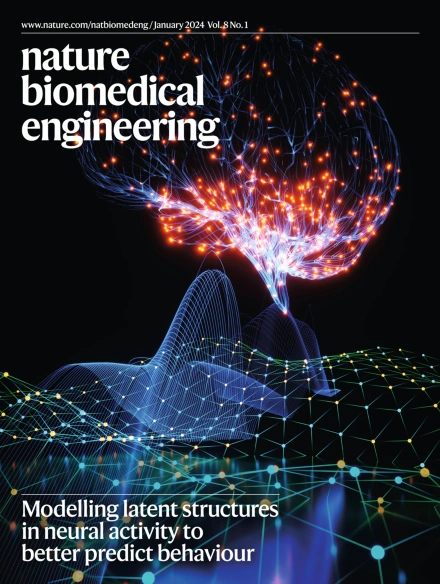可伸缩高密度皮质微电极阵列的微创植入用于多模态神经解码和刺激。
IF 26.8
1区 医学
Q1 ENGINEERING, BIOMEDICAL
引用次数: 0
摘要
高带宽脑机接口依赖于侵入性外科手术或脑穿透电极。在这里,我们描述了一种皮质1024通道薄膜微电极阵列,并在猪模型和尸体上展示了它的微创手术交付,避免了开颅手术。我们展示了用相同的电极记录和刺激皮层表面的大部分区域,以及在不损伤皮层表面的情况下将植入物输送到大脑的多个功能区域的可逆性。我们评估了高密度神经记录和可视化皮层表面活动界面在空间和时间分辨率和总空间范围的性能。我们展示了对躯体感觉、视觉和意志行走活动的精确神经解码,并通过亚毫米尺度的皮层刺激实现局灶性神经调节。我们报告了术中使用该设备的可行性,在一项5例麻醉和清醒神经外科患者的初步临床研究中,表征了皮层表面感觉运动活动和语言的空间尺度。所提出的神经接口展示了微皮质电成像的高度可扩展性及其在下一代脑机接口中的应用。本文章由计算机程序翻译,如有差异,请以英文原文为准。
Minimally invasive implantation of scalable high-density cortical microelectrode arrays for multimodal neural decoding and stimulation.
High-bandwidth brain-computer interfaces rely on invasive surgical procedures or brain-penetrating electrodes. Here we describe a cortical 1,024-channel thin-film microelectrode array and we demonstrate its minimally invasive surgical delivery that avoids craniotomy in porcine models and cadavers. We show recording and stimulation from the same electrodes to large portions of the cortical surface, and the reversibility of delivering the implants to multiple functional regions of the brain without damaging the cortical surface. We evaluate the performance of the interface for high-density neural recording and visualizing cortical surface activity at spatial and temporal resolutions and total spatial extents. We demonstrate accurate neural decoding of somatosensory, visual and volitional walking activity, and achieve focal neuromodulation through cortical stimulation at sub-millimetre scales. We report the feasibility of intraoperative use of the device in a five-patient pilot clinical study with anaesthetized and awake neurosurgical patients, characterizing the spatial scales at which sensorimotor activity and speech are represented at the cortical surface. The presented neural interface demonstrates the highly scalable nature of micro-electrocorticography and its utility for next-generation brain-computer interfaces.
求助全文
通过发布文献求助,成功后即可免费获取论文全文。
去求助
来源期刊

Nature Biomedical Engineering
Medicine-Medicine (miscellaneous)
CiteScore
45.30
自引率
1.10%
发文量
138
期刊介绍:
Nature Biomedical Engineering is an online-only monthly journal that was launched in January 2017. It aims to publish original research, reviews, and commentary focusing on applied biomedicine and health technology. The journal targets a diverse audience, including life scientists who are involved in developing experimental or computational systems and methods to enhance our understanding of human physiology. It also covers biomedical researchers and engineers who are engaged in designing or optimizing therapies, assays, devices, or procedures for diagnosing or treating diseases. Additionally, clinicians, who make use of research outputs to evaluate patient health or administer therapy in various clinical settings and healthcare contexts, are also part of the target audience.
 求助内容:
求助内容: 应助结果提醒方式:
应助结果提醒方式:


